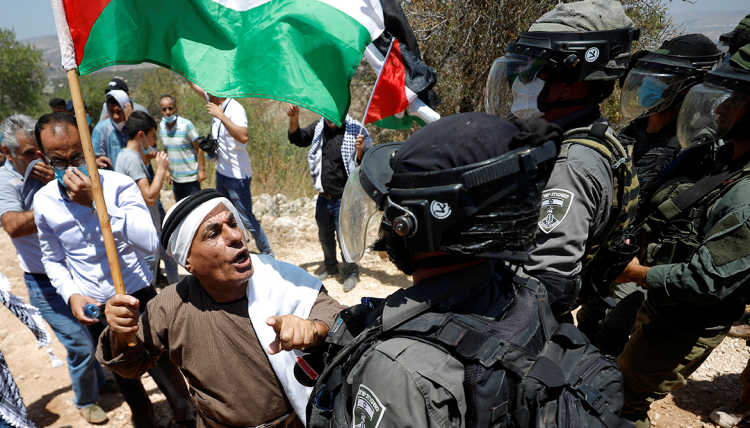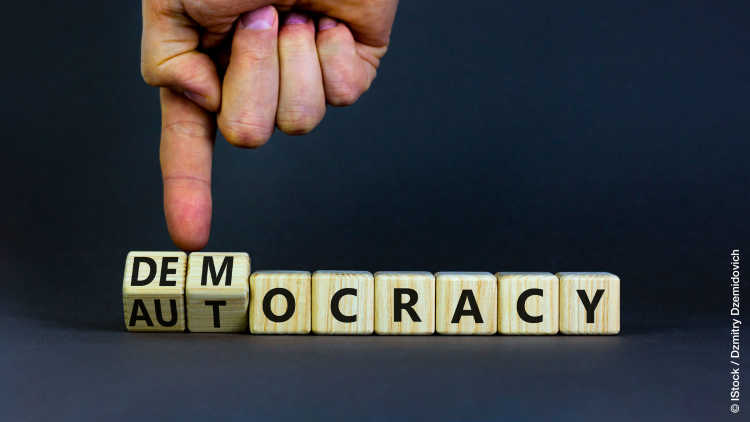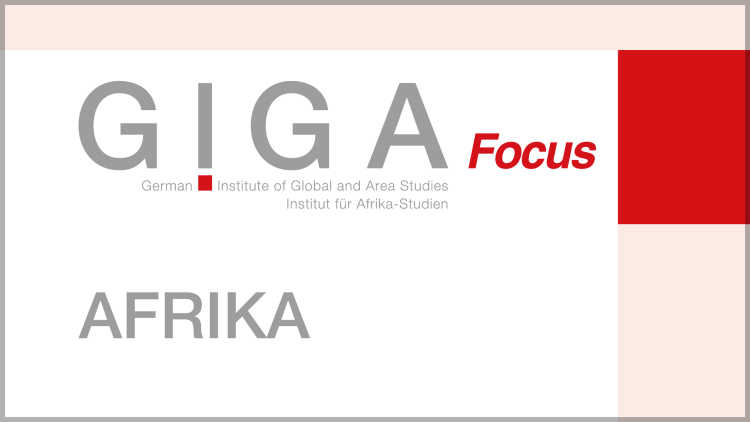- Home
- Publications
- GIGA Focus
- Doomed to Instability: Israel's West Bank Annexation Plan in a Turbulent Region
GIGA Focus Middle East
Doomed to Instability: Israel's West Bank Annexation Plan in a Turbulent Region
Number 4 | 2020 | ISSN: 1862-3611

Israel’s recent plan to annex parts of the West Bank threatens the stability of Jordan along with the Palestinian territories and Israel itself. To understand the repercussions of annexation, we must examine the positions of the relevant actors and their potential responses to the Israeli plan. Three constellations of actors can be singled out: de facto accepters, weak opposers, and militant revisionists.
Despite the Gulf states’ and Egypt’s condemnation of the annexation plan, they will not take concrete measures to thwart it, due to their evolving relations with Israel and their reliance on the United States. This de facto acceptance by Egypt and the Gulf states weakens the position of the Kingdom of Jordan and the Palestinian Authority (PA) in advocating against the proposed plan.
The prospective annexation will directly and negatively impact the Kingdom of Jordan and the Palestinian Authority in the West Bank. However, because of their own internal challenges, the absence of regional Arab support, and their dependence on Israel and the United States on different issues, Jordan and the PA lack the capacity to offset the Israeli plan.
The Islamist militant factions in the Palestinian territories oppose the annexation plan and seem capable of turning their escalatory rhetoric against Israel into violent action. The probability of this happening might increase if the Palestinian Authority collapses in the West Bank.
Policy Implications
The annexation plan runs counter to the EU’s foreign policy vis-à-vis the Israeli–Palestinian peace process. The EU should work collectively to dissuade Israel from implementing the annexation plan by applying diplomatic and, if necessary, economic pressure. Additionally, the EU should support Jordan’s anti-annexation diplomatic campaign. The Palestinian Authority should receive the EU’s political and financial backing as long as the PA commits to comprehensive reforms.
On 28 May 2020 Israeli prime minister Benjamin Netanyahu announced his commitment to annexing 30 per cent of the West Bank as of 1 July, a proposal met by international and regional condemnation, to say nothing of Palestinian denunciation. The date set was later pushed back without another date being named. Although the fallout from implementing the annexation plan is hard to forecast precisely, intra-Palestinian dynamics and regional complexity should not be underestimated as factors that may lead to another violent escalation and heightened instability in Israeli–Palestinian relations.
Mapping the various actors relevant to the potential annexation and their stances on it is crucial to highlighting the potential sources of instability should Israel proceed with the scheme. In this vein, three constellations of actors can be singled out: de facto accepters, states that seem not to prioritise the Palestinian cause on their agendas with Israel and hence will not undertake substantial moves to prevent the prospective annexation; weak opposers, actors that oppose the Israeli plan and will be directly affected by it, yet have no realistic tools to thwart it; and militant revisionists, non-state Islamist armed groups whose strategic depth derives from the support of regional powers and who stand against annexation and may resort to violence to offset it.
De Facto Accepters: The Gulf Arab States and Egypt
With regard to their rhetoric, it should be emphasised that the position of the Gulf Arab states and Egypt is similar to that of the UN, EU, and the other Arab states in criticising the plan to annex and calling on Israel to abide by the rules of international law. However, an observation of the evolving cooperation between the Gulf Arab states, Egypt, and Israel reveals deeper relationships and coordination in a multitude of fields and strategic postures. For example, the Kingdom of Saudi Arabia and the United Arab Emirates share the Israeli perception that Iran is a major threat in the region (Beck 2019), especially given its remarkable expansion in Syria, Yemen, Iraq, and Lebanon, and its proxy, cyber, nuclear, and missile programmes.
Additional factors indicate the Gulf Arab states’ desire to “normalise” relations with Israel; take, for example, the frequent meetings between Israeli and Gulf state officials, including Netanyahu’s visit to Muscat in 2018, the Israeli foreign minister’s meeting with his Bahraini counterpart in Washington in 2019, and Netanyahu’s meeting with senior Arab officials at the Warsaw Summit, organised by the United States in 2019. Further, an Israeli pavilion is currently under construction in Dubai, which is preparing to host the postponed Expo 2020 in 2021 and to potentially allow Israeli passport holders to enter Dubai on those passports. Qatar is also considering granting a similar permission to enable Israeli citizens to attend the prospective FIFA World Cup 2022 in Qatar (Ferziger and Bahgat 2020). Cooperation in the medical realm is also underway – in particular in regard to the COVID-19 pandemic, whereby three member states of the Gulf Cooperation Council (GCC), including Bahrain, contacted Israeli medical centres for assistance and information on the virus (Harkov 2020). Also, Israeli technology is in demand among the Gulf Arab states, especially in fields such as cyber-spying, desert agriculture, and desalination.
As regards Egypt, a phone call between presidents Abdel Fattah el-Sisi (Egypt) and Mahmoud Abbas (Palestinian Authority) took place on 20 July 2020 and was followed by a visit of the Egyptian foreign minister, Sameh Shoukri, to Ramallah on 21 July. El-Sisi and Shoukri both reiterated Egypt’s support for the rights of the Palestinian people and its opposition to the Israeli unilateral plan. Nevertheless, countering the annexation plan seems for various reasons to not be an Egyptian priority. First, Egypt is facing the spread of COVID-19, which has damaged its economy mainly because remittances from the GCC countries have been curtailed and tourism suspended. Second, Ethiopia’s so-called “Grand Renaissance Dam” sits atop Cairo’s agenda, as continuous negotiations between Egypt and Ethiopia have been ongoing for almost a decade without having yielded tangible results. As Egypt hinges on US support vis-à-vis the dam negotiations, it is not predisposed to disappoint the administration of President Donald Trump over the annexation plan, especially given that the Trump “Peace to Prosperity” plan for the Middle East has further emboldened Netanyahu to call for annexation. Third, the unfolding clashes in Libya have complicated the Egyptian situation and the prospects for Egypt’s support for Khalifa Haftar against the UN-recognised Government of National Accord (GNA) in Libya. Here, too, Egypt looks to the United States to curb the Turkish intrusion. Fourth, Egyptian–Israeli relations are flourishing and multifaceted to the extent that Egypt coordinates with Israel in combatting the Islamist insurgency in the Sinai Peninsula; imports gas from Israel and was one of the signatories to the Eastern Mediterranean Gas Forum (along with Israel and other regional countries); and relied on Israel in 2013 to undo the US suspension of USD 1.3 billion aid to Egypt. Finally, Cairo’s relations with its Palestinian neighbours are not optimal, in particular with Hamas, which holds power in the Gaza Strip and is viewed by Egypt as an affiliate of the Muslim Brothers, the fierce enemies of President el-Sisi (Boxerman 2020). In short, Egypt is overwhelmed by an array of imminent domestic and regional challenges, and it is highly improbable that it would risk its strong ties with the United States and Israel to work effectively against the annexation plan.
Weak Opposers: Jordan and the Palestinian Authority
In Jordan, top-ranking officials such as the prime minister and the minister of foreign affairs publicly condemned the Israeli plan and warned against its implementation. Further, King Abdullah II asserted in an interview with Der Spiegel in May 2020, “If Israel really annexes the West Bank in July, it would lead to a massive conflict with the Hashemite Kingdom of Jordan,” and hinted that all options are conceivable, including reconsidering its 1994 peace treaty with Israel (Der Spiegel 2020). Despite the ambiguity in the potential Jordanian response to the next Israeli move, Jordan will be directly impacted if Israel fulfils its intention and annexes parts of the West Bank: Jordan already hosts more than two million registered Palestinian refugees and will be further pressured demographically, economically, and in security terms should the annexation transpire, which may lead to the forced migration of more Palestinians from the West Bank to Jordan. In addition, the Israeli plan could also jeopardise the Hashemite regime’s status as the custodian of the holy Muslim shrines in Jerusalem as recognised by Article 9 of the Israeli–Jordanian peace treaty.
Although Jordan will be threatened if the annexation materialises, it is highly improbable that the country could avert it: The already strained Jordanian economy is a perpetual beneficiary of US aid and financial support. Furthermore, Jordan signed a USD 10 billion gas import deal with Israel in 2016, which is set to last for 15 years and is expected to guarantee stable energy prices for Jordan, saving the kingdom up to USD 500 million per annum, thus reducing the perennial budget deficit. The interdependence between Israel and Jordan is, likewise, profound in terms of security, military, and intelligence cooperation in counterterrorism and against smuggling, and has proven rather immune to political fluctuations (Riedel 2020). Hence, it is hard to imagine how Jordan will manage those interconnected issues if it takes concrete steps towards abrogating the 1994 peace treaty. Further, although the 1994 peace treaty with Israel is unpopular on the streets of Jordan, it represents the legal framework that organises the relationship between the two countries, including Jordan’s access to water, transportation, access to ports, civil aviation, tourism, and so on, which makes revoking it without clear alternatives more of a leap into the darkness rather than a prudent choice. Finally, Jordan’s warnings lack regional endorsement from its Gulf allies and diverge from the US prioritisation of Israeli interests. In short, the stakes for Jordan are too high if it abrogates the peace treaty and it seems unrealistic that it could afford this option. However, the kingdom will heavily invest in all peaceful means available to prevent annexation.
After the announcement of the creation of the Netanyahu–Gantz unity government, which is officially considering the annexation of parts of the West Bank, President Mahmoud Abbas, head of the Palestinian Authority (PA) which rules over areas of the West Bank, unilaterally declared on 19 May that all previous agreements, understandings, and commitments between the PA and the Israeli and American governments, including security agreements, would be ended. This has not (yet) come to fruition, and it is noteworthy that Abbas has made similar announcements on different previous occasions without seeing them through.
Notwithstanding the true intention of Abbas, the PA’s dilemma is two-pronged: First, the extent to which the PA is dependent on Israel in terms of security, economics, governance, and administration makes it too weak in its current status to prevent the annexation should it go forward. Second, if the PA disengages from all its agreements with Israel, this would mean a dismantling of the Oslo Accords, the very agreement upon which the PA was established, thus an abandonment of the structures of its ruling capacity. This second scenario could be tantamount to the collapse of the PA and may create a vacuum that can realistically be filled only by Hamas (Melman 2020), hence increasing the chances for violence. Put differently, the PA might prove a disruptive actor not because of its proactive ability to clash with Israel upon its planned annexation; rather, the PA’s disruptive potential stems from its very collapse.
To be sure, the disintegration of the PA can result from factors other than cutting its ties with Israel. To illustrate, a set of drawbacks characterise the representativeness and performance of the PA, such as the blurred institutional boundaries between the PA and Palestinian Liberation Organisation (PLO); the suspension of the Palestinian Legislative Council’s elections since 2006; the persistence of the geographical and administrative split between the West Bank and the Gaza Strip since 2007 without a constructive dialogue having been embarked on by the PA that would include the other Palestinian factions with whom it has feuded and pave the way for a national reconciliation; and the ageing political leadership that is reluctant to open space for the participation of younger generations (Rahman 2019). These realities, among other things, have led to a dwindling legitimacy of the PA and in particular of President Abbas in recent years, which suggests that the PA is already fragile and may not withstand the annexation if it comes into force. The beneficiaries of the PA’s precariousness would be the Palestinian factions that enjoy higher levels of acceptance among the Palestinian people and have non-trivial institutional networks in the West Bank, primarily Hamas.
Militant Revisionists: Hamas and the Islamic Jihad
The Islamic Resistance Movement (known as Hamas) and the Islamic Jihad Movement in Palestine (PIJ) are two Palestinian Sunni-Islamist organisations that govern the Gaza Strip. Along with their respective militant wings, the Izz al-Din al-Qassam Brigades and Al-Quds Brigades, they played pivotal roles in mobilising the so-called Second Intifada that erupted against Israel and lasted between 2000 and 2005. Hamas and the PIJ follow similar ideological lines vis-à-vis the Palestinian–Israeli conflict, rejecting the two-state solution, aiming to liberate the entirety of the occupied Palestinian territories, and not recognising the State of Israel. To be sure, Hezbollah of Lebanon can be conceptually added to this constellation. However, it is unlikely that Hezbollah will be directly involved in any violent escalation between the Palestinian Islamist factions and Israel due to its exhaustive combat operations in Syria, the increased international sanctions against it, and the economic and socio-political hardships that Lebanon is facing.
According to the Israeli Ministry of Foreign Affairs (MFA), Iran has been providing the militant factions in the Palestinian territories with financial, operational, and military supplies since the inception of the Islamic Republic in 1979 (MFA 2003) – a fact not denied by Hamas or the PIJ. With Trump’s “Peace to Prosperity” plan in January 2020 and the official endorsement of the annexation plan by the newly formed Israeli coalition government, the Islamist factions in the Gaza Strip adopted a stronger tone of rejection towards both plans. In this regard, the spokesperson of the Al-Quds Brigades called on Palestinians to attack Israeli military checkpoints (Memo 2020). Also, the spokesperson for the Al-Qassam Brigades stated that Israel’s plan is a “declaration of war against the Palestinian people” (Asharq Al-Awsat 2020), whereas his Hamas counterpart emphasised that “resistance” is the best strategic option for the Palestinians to thwart the annexation.
Beyond their escalatory rhetoric, Hamas and the PIJ have also been consolidating their regional ties and domestic tactics in recent years to bypass the siege imposed on the Gaza Strip since 2007. Politically, the leaderships of the PIJ and Hamas have been making noticeable efforts to restore their relations with the Iranian and Syrian leaderships following the deterioration in relations caused by the refusal of the PIJ and Hamas to side with the Syrian leadership in the Syrian war. Since 2012, Hamas and the PIJ have abandoned their offices in Damascus and moved to Qatar, with Iran suspending its financial support to them. Today, those ties seem to be flourishing again, with the head of Hamas’ Political Bureau, Ismail Haniyeh, receiving a message from the Iranian supreme leader, Ali Khamenei, which assured Iranian support for the Palestinian people against annexation. Similarly, Haniyeh and the secretary-general of the PIJ were contacted on 1 July by the Iranian Shura Council spokesperson to review the potential mechanisms for countering annexation.
Hamas has also been attempting to improve its relations with Jordan since 2019, when Haniyeh and other Hamas officials reiterated their support for Jordan and asserted their appreciation of the king’s stance on the annexation plan. Whether the rapprochement between Hamas and Jordan is forthcoming is not yet clear; nevertheless, the kingdom may face obstacles on this issue given the US classification of Hamas as a terrorist organisation and the potential sensitivity of the PA to such a rapprochement.
Maybe the least expected of all was the conciliatory meeting between long-time rivals Hamas and Fatah (formerly known as the Palestinian National Liberation Movement), the historic predecessor of the PA. The two prominent factions agreed to join forces to forestall the annexation plan that threatens the future of the national Palestinian project and the inalienable rights of the Palestinian people.
In the economic realm, the Gaza Strip, including Hamas and the PIJ, has been under a chronic blockade from Israel, the PA, and Egypt on items as vital as goods, energy, access to ports, money flows, and so on, which has rendered the PIJ and Hamas more dependent on Iran. However, after 2012 the Iranian financial lifeline was allegedly cut, which synchronised with the two factions’ move from Syria to Qatar and their subsequent dependence on Qatari aid. Nevertheless, the Qatari financial backing came, according to a member of Hamas’ Political Bureau, with stipulations on the behaviour of Hamas and in favour of non-escalation with Israel (Abu Aisha 2019). Today, with the improvement between Hamas, the PIJ, and Iran, the two factions seem more confident that their finances will be buttressed by Iran again, whose support comes unencumbered by prerequisites. Of course, pinpointing the networks that Iran used, and will use, to transfer money into the Gaza Strip is exceedingly difficult.
A new path that Hamas is treading to raise funds is bitcoin: the Al-Qassam Brigades, the armed wing of Hamas, is experimenting with a cryptocurrency-based funding campaign and has issued a two-minute video on its website that explains in detail how its supporters can donate bitcoin (alqassam.net). A report by Reuters contends that what makes this mechanism hard to trace is the creation of a new digital wallet with each transaction (Wilson and Williams 2019). The point here is not mainly the amount of funds that Hamas will be garnering from this new method; rather, it is the endeavour to cope with the blockade and to escape the traditional, years-old measures of financial scrutiny by the Israeli authorities.
The persistent besiegement of the Gaza Strip has not only crippled the economic and financial resources of the PIJ and Hamas, it has also curtailed their military outsources. A big blow in this regard was the closure in 2013 by President El-Sisi of the tunnels underneath the Egypt–Gaza border, which deprived Hamas and the PIJ of smuggled weapons and goods and the ensuing tax income. In spite of that, the building up of forces within the blockaded Gaza does not seem to have ebbed dramatically. One demonstration of the PIJ’s ability to pose a threat to the Israeli territories took place in 2019 when the Israel Defence Forces (IDF) assassinated the commander of the Al-Quds Brigades in the northern Gaza Strip. The PIJ responded to this operation by launching 450 rockets at Israel. The IDF combat engagement focused primarily on targeting the PIJ’s launch units and the corresponding storage and manufacturing infrastructures. The confrontation was relatively short and ended with a ceasefire agreement (Dekel 2019).
In the same vein, Hamas has also developed an arsenal with effective and advanced weaponry (self-made and previously smuggled), which includes shoulder-launched anti-aircraft missiles, guided anti-tank missiles, and an array of rockets with improved ranges and a network of attack and defence tunnels under the Gaza–Israel fence, allegedly in addition to a preliminary drones programme (Akram 2019). In short, Hamas and the PIJ have worked towards circumventing the imposed siege on Gaza, continuing to develop their arsenals, networks, and tactics.
To sum up, amongst the three delineated constellations of actors relevant to the West Bank annexation plan, Hamas and the PIJ appear as the only players who can substantiate their escalatory rhetoric via resorting to violence. Both organisations have been investing in improving their regional political ties, economic survival modes, and military resilience under suffocating blockade conditions. Their dependence also hinges primarily on Iran, a major foe of Israel that might have an interest in enmeshing Israel in a domestic battle to distract it from systematically targeting itself and Hezbollah in Syria. To put it differently, the PIJ and Hamas, unlike the Gulf countries, Egypt, Jordan, and the PA, will not lose US endorsement or sacrifice their multifaceted ties with Israel should they make good on their threats to Israel and its annexation plan. Also, the record of Hamas–IDF and PIJ–IDF armed confrontations shows that Hamas and the PIJ do not usually prefer negotiations.
Options for the European Union
If implemented, the annexation plan will pose a strategic threat to Jordan and its stability. It will also mean the end of decades of peace negotiations between Israel and the PA and the termination of the two-state solution and the Oslo Accords. This, in turn, will lead to heightened radicalisation among the militant Islamist groups (mainly Hamas and the PIJ) in the Palestinian territories and may instigate new episodes of violence and destruction. To prevent this gloomy fate, the EU should follow a bifurcated policy. First, in terms of Israel, the EU must arrive at a unanimous agreement to push Israel diplomatically in order to convince it of the probable negative repercussions of annexation. To this end, the EU should also consider imposing economic sanctions on Israel should it proceed with its plan. Second, in terms of Jordan and the PA, it is worth remembering that they are the moderate actors with whom Israel has been dealing for decades on Palestinian–Israeli issues. Thus, the political and diplomatic position of Jordan should be buttressed by the EU both on the international level and vis-à-vis Israel.
In regard to the PA, it is imperative that the PA continue to act as the representative of the Palestinians before the international community and as the governing authority in the West Bank. However, the PA’s survival should be coupled with a comprehensive reform of its political and operative structures to guarantee that a national dialogue is initiated that includes all the Palestinian factions and aims to end the political and geographic separation between the Gaza Strip and the West Bank. These reforms should also include holding elections for a new legislative council; clarifying the institutional boundaries of the PLO and the PA; opening the PA for broader membership of actors from outside Fatah; and paving the way for younger generations to replace the already aged leadership.
Footnotes
References
Abu Aisha, Izz El-deen (2019), “ishkalaat almal alqatari ‘ila Hamas”, in: Arab Independent, https://bit.ly/2DhP2DJ (18 July 2020).
Akram, Fares (2019), Hamas Has Developed a Vast Arsenal in Blockaded Gaza, AP NEWS, 25 March, https://apnews.com/9977b51fc0754009b932c860daef579e (04 August 2020).
Asharq Al-Awsat (2020), “Annexation Is Declaration of War,” Says Hamas’ Qassam Brigades, Asharq AL-Awsat, 26 June, https://english.aawsat.com/home/article/2355126/annexation-declaration-war-says-hamas%E2%80%99-qassam-brigades (04 August 2020).
Beck, Martin (2019), Israel and the Arab Gulf: An Israeli-Saudi Alliance in the Making?, E-International Relations, November, 5.
Boxerman, Aaron (2020), Why Egypt Is Staying Quiet on Israel’s West Bank Annexation Plan, 29 June, www.timesofisrael.com/why-egypt-is-staying-quiet-on-israels-west-bank-annexation-plan/ (04 August 2020).
Dekel, Udi (2019), Fighting against Islamic Jihad: Serving an Arrangement in the Gaza Strip, INSS (blog), 18 November, www.inss.org.il/publication/fighting-against-islamic-jihad-serving-an-arrangement-in-the-gaza-strip/ (04 August 2020).
Der Spiegel (2020), Jordan’s King Abdullah II: “The Danger of People Starving to Death Is Greater than the Danger from the Virus Itself”, Der Spiegel, 15 May, www.spiegel.de/international/world/jordan-s-king-abdullah-ii-the-danger-of-people-starving-to-death-is-greater-than-the-danger-from-the-virus-a-4b220928-7ff9-4219-a176-ec380ec16cf3 (04 August 2020).
Ferziger, Jonathan H., and Gawdat Bahgat (2020), Israel’s Growing Ties with the Gulf Arab States, in: Atlantic Council, July, 20.
Harkov, Lahav (2020), Three Gulf States Seek Partnership with Israel to Fight Coronavirus’, in: The Jerusalem Post, 10 May, https://www.jpost.com/Israel-News/Three-Gulf-states-seek-partnership-with-Israel-on-fighting-coronavirus-627536.
Melman, Yossi (2020), Netanyahu and Abbas Are Making Promises They Hope to Break, in: Middle East Eye, 26 May, www.middleeasteye.net/news/netanyahu-and-abbas-are-making-promises-they-hope-break (04 August 2020).
Memo (2020), Palestinian Armed Wing Calls for Attacks on Israel, Middle East Monitor, 07 February, www.middleeastmonitor.com/20200207-palestinian-armed-wing-calls-for-attacks-on-israel/ (04 August 2020).
MFA (2003), Iranian Activities in Support of the Palestinian Intifada, 30 January, https://mfa.gov.il/MFA/MFA-Archive/2003/Pages/Iranian%20activities%20in%20support%20of%20the%20Palestinian%20i.aspx (04 August 2020).
Rahman, Omar (2019), From Confusion to Clarity: Three Pillars for Revitalizing the Palestinian National Movement, Brookings (blog), 12 December, https://www.brookings.edu/research/from-confusion-to-clarity/ (04 August 2020).
Riedel, Bruce (2020), With Israel’s Annexation Plans Looming, an Hour of Decision for Jordan’s Hashemites, Brookings (blog), 1 June, https://www.brookings.edu/blog/order-from-chaos/2020/06/01/with-israels-annexation-plans-looming-an-hour-of-decision-for-jordan/ (04 August 2020).
Wilson, Tom, and Dan Williams (2019), Hamas Shifts Tactics in Bitcoin Fundraising, Highlighting Crypto Risks: Research, Reuters, 26 April, www.reuters.com/article/us-crypto-currencies-hamas-idUSKCN1S20FA (04 August 2020).
General Editor GIGA Focus
Editor GIGA Focus Middle East
Editorial Department GIGA Focus Middle East
Research Project
Regional Institutes
Research Programmes
How to cite this article
Almohamad, Selman (2020), Doomed to Instability: Israel's West Bank Annexation Plan in a Turbulent Region, GIGA Focus Middle East, 4, Hamburg: German Institute for Global and Area Studies (GIGA), https://nbn-resolving.org/urn:nbn:de:0168-ssoar-68969-5
Imprint
The GIGA Focus is an Open Access publication and can be read on the Internet and downloaded free of charge at www.giga-hamburg.de/en/publications/giga-focus. According to the conditions of the Creative-Commons license Attribution-No Derivative Works 3.0, this publication may be freely duplicated, circulated, and made accessible to the public. The particular conditions include the correct indication of the initial publication as GIGA Focus and no changes in or abbreviation of texts.
The German Institute for Global and Area Studies (GIGA) – Leibniz-Institut für Globale und Regionale Studien in Hamburg publishes the Focus series on Africa, Asia, Latin America, the Middle East and global issues. The GIGA Focus is edited and published by the GIGA. The views and opinions expressed are solely those of the authors and do not necessarily reflect those of the institute. Authors alone are responsible for the content of their articles. GIGA and the authors cannot be held liable for any errors and omissions, or for any consequences arising from the use of the information provided.

































